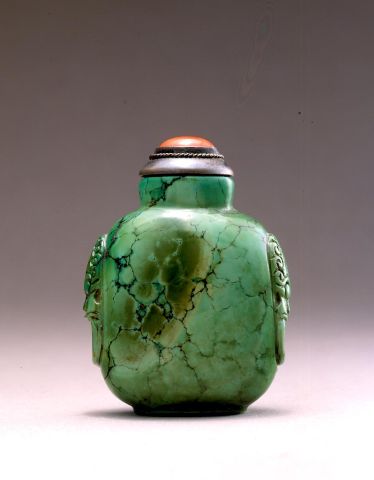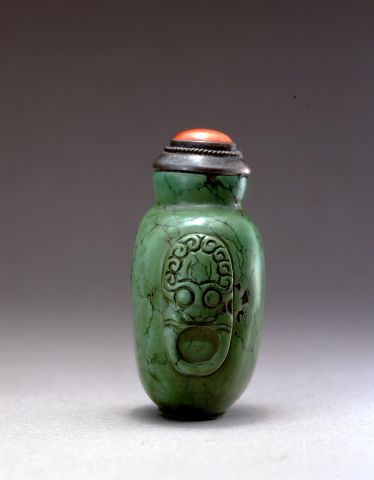

Bottle ID: 87
SMALL, WITH RING HANDLES
Date: 18th century
Height: 44 mm
Turquoise, well patinated, of small bulbous square form with rounded shoulders, and a neatly carved footrim, the sides carved with large mock mask and ring handles, the body with an irregular matrix.
Similar Examples:
Crane Collection no. 417
Snuff Bottles of The Ch'ing Dynasty: Catalogue of an exhibition at the Hong Kong Museum of Art, 1978, p. 59, no. 38.
Kleiner, Robert W. L. Chinese Snuff Bottles from the Collection of John Ault, 1990, p. 77, no. 131.
Holden, Rachelle R. Rivers and Mountains Far From the World - The Rachelle R. Holden Collection, 1994, p. 364, no. 161.
Provenance:
Clare Lawrence Ltd.
Turquoise matrix is described as a cryptocrystalline aggregate with very fine, almost invisible, crystals. It is composed of hydrous copper aluminum phosphate with iron, resulting in its porous qualities and is a fairly soft material, which can be scratched with a knife. The dark, spidery veins in the matrix surrounding the blue/green material are limonite. However it is one of the stones less likely to be confused with other materials than any other stone in the snuff bottle world. The Chinese took great pleasure in the imitation of one material by another, particularly in the manufacture of snuff bottles. The bottle from the Ault Collection cited here is a realistic example of a glazed porcelain imitating turquoise. However, the imitation of this stone is neither new or exclusive to the Chinese. The early Egyptians were the first culture to produce a glazed earthenware termed faience, which deliberately resembled the highly esteemed turquoise. Later on glass and enamel imitations also appeared, as seen on the iconic gold burial mask of Tutankhamun, where both turquoise and lapis lazuli are imitated. The other Ault bottle cited here, which is turquoise, is given because of its small size, but in terms of material the Ault example is much more similar to the Crane turquoise, no. 282 with its definitive green tone and lack of veining.
< Back to full list
 English
English 中文
中文